INSTITUTE OF PHILOSOPHY OF NATURE
Abstract
Space is now considered as a physical medium capable of interacting with matter. Thus, any relative motion of the orbital body in the space medium is subject to loss of the speed of motion of the orbital body due to the resistance offered by the space medium. But the orbital bodies maintain their state of motion indefinitely. There is an absolute need of continuous motive force for the perpetual motion of the celestial bodies. As of today, the only known gravitational interaction in the solar system is unable to provide the required motive force. The newly introduced non-electric charge concept is helpful in providing the required motive force from celestial charge (non-electric) interaction. The paper discusses the celestial charge interaction in providing the motive force for different motions such as the orbital motion, rotational motion and oscillation of the axis of the orbital body relative to the central body. The celestial body accelerates in the above motions by celestial charge interactions against the resistance of the space medium. The resistance of the space medium increases rapidly with the increase of velocity of the celestial body thereby the motions of the celestial body stabilize at different specific speeds where the effective motive force becomes zero. In this manner the motions of the celestial body are perpetual.
Key Words: Celestial bodies, Perpetual rotation, Oscillation of axis, Motive force, non-electric charge concept, Celestial charge interactions, Resistance of space medium.
Introduction
The celestial bodies of the solar system have different speeds of rotation. Neither do we visualize a driving torque derived from gravitational interaction for the rotational motion nor do we realize the resisting torque from empty space for slowing down the speed of rotation. It is presumed that the speed of rotation of the celestial body in the solar system developed during the formation process of the solar system is simply continuing due to the mass moment of inertia. Theoretically, the presumption appears sound. But in reality, the space is physical and capable of rendering propagation of high frequency light waves and forming space-time curvature that guides the motions of celestial bodies. Hence, the physical space can as well offer resistance to different motions of orbital bodies and slow down their motions. Thus, it is rational to think of a constant motive torque for rotation of celestial bodies which would overcome the resistance to rotational motion thereby maintaining a constant speed of rotation. The author has described the new concept of space, where space itself is physical and contains space matter particles in finer domains [1] [2]. Thus, it is reasonable to think of the existence of the resistive torque that would slow down the speed of rotation in the absence of a motive torque to overcome the resistive torque. Since the speed of rotation is not slowing down, it establishes the existence of a hidden driving torque. Gravity is the only known force interaction for the dynamics of the solar system but gravity acts along the line joining the centers of celestial bodies. Hence gravity cannot produce a turning moment for an orbital celestial body to cause rotation about its own axis. It becomes obvious that some non-gravity force is producing the turning moment to maintain a constant speed of rotation. The new non-electric charge (celestial charge) interaction produces the required turning moment for rotation and oscillation of the orbital body. Hence, both gravity and celestial charge interaction are inevitable in working out the dynamics of celestial bodies in the solar system. The celestial charge interaction has a role in evaluation of centripetal force. In this new consideration the centripetal force is a combination of gravity and celestial charge force. The force of gravity is invariant whereas the celestial charge interaction is a variable force depending on the surface charge state of celestial bodies.
Non-electric charge interaction for rotation of orbital body
We are conversant in the electric charge interaction of particles where electrons and protons are electric charge carriers. As of today, we have no knowledge as to how charge appears in fundamental particles. This author has given a new understanding of electric charge appearing in micro particles due to non-equilibrium mass-space association in relation to the equilibrium mass-space association of its background. Matters in the background having equilibrium space holding behave neutral among them but interact with the micro particles having non-equilibrium space holding. The micro particles in non-equilibrium mass-space state are in active state or in charge state. Hence, charge is not a separate entity other than the state property of matter (mass-space integral system). Matter exists in different domains (macro domain, micro domain, micro-micro domain etc…). Matter in any domain is a mass-space integral system therefore the concept of charge is extendable to all domains to understand other non-electric charges. The cause of charge remaining the same in matters of all domains the strength and range of interaction becomes different depending on density of mass/space and the domain scale change which classify the charge as electric and non-electric. More specifically the charge in the micro domain is known as electric charge and the non-electric charge in micro-micro domain & macro domain are newly introduced as photonic charge and celestial charge respectively. Charge being a non-equilibrium state of mass and space, a charged matter may have less space holding or more space holding than the equilibrium space holding per unit of mass. The mass rich proton is in the state of positive charge and the space rich electron is in the state of negative charge. The negative and positive electric charge don’t relate to absolute property but only a relative state property of mass space ratio. Following this concept of charge the mass rich celestial bodies possess positive celestial charge and space rich celestial bodies carry negative celestial charge. Similarly, the mass rich photons carry positive photonic charge and space rich photons carry negative photonic charge. In the new charge concept the positive and negative charges are of the same type and charge interaction takes place only at charge potential difference. When mass rich micro particles or micro-micro particles are absorbed in a macro celestial body, it makes the surface of the celestial body rich with the mass component making the surface of the celestial body positively charged. On the other hand, when space rich micro particles or micro–micro particles are absorbed in a macro celestial body, makes the surface of the celestial body rich with space components making the surface of the celestial body negatively charged. The emission of mass rich and space rich micro particles or micro-micro particles from the surface of a celestial body changes the celestial charge state of the surface of the celestial body. The gravitational interaction acts through the line joining the mass through the celestial bodies, whereas the line of action of charge force depends on the local surface charge state of the celestial bodies. The line of action of local celestial charge interaction is generally off centered to center of mass. Hence, differential charge attraction has scope to produce turning moment on orbital celestial body.
Constant acting hidden torque for perpetual rotation of orbital bodies
The direction of rotation is initiated by the differential turning moment due to the thrust of spinning space fluid of the central body [3]. The thrust becomes insignificant when the tangential velocity of the orbital body approaches the tangential velocity of the spinning fluid. But the resistance to rotational motion of the celestial body increases with increasing speed of rotation. To counter the resistance of space fluid additional effort (torque) is required and this is provided by the new celestial charge interaction.
In the new concept, celestial bodies carry celestial charge and light particles carry photonic charge. The sun carries positive celestial charge and planets carry negative celestial charge [4]. The negative celestial charge of the surface of a planet reduces by absorbing positively charged solar radiation particles (photons) [4]. The negative celestial charge state of the surface of the planet increases by releasing positively charged photons (earthly radiation) and receiving the negatively charged background radiation. The thermal and electric potentials of the surface of a planet are measures of the celestial charge state of a planet. Planets receive solar radiation on the sun facing side of the planet. At any instant, only one hemisphere of a planet receives sunlight which is referred to as day time part of the planet and the other hemisphere without sunlight is referred to as night time part of the planet. The morning hemisphere has a half day portion and half night portion. The surface of the planet receiving the solar radiation absorbs a fraction of it thereby reducing the negative celestial charge state of the surface. During night, the solar radiation does not reach the surface hence the celestial charge state of the surface of the planet becomes more and more negative with laps of time due to loss of positively charged photons by terrestrial radiation. This makes the negative celestial charge of the surface of the morning hemisphere more than that of the evening hemisphere. Hence, the charge attraction of the sun to the morning hemisphere is more than that of the evening hemisphere (Fig.1). The unbalanced celestial charge attraction produces a torque on the planet to rotate about its own axis where the morning hemisphere moves towards the sun resulting in anticlockwise torque for anticlockwise rotation of the planet. This torque is present in all times and it goes to counter the resistance to rotational motion of the planet thus the rotation of planets is perpetual.
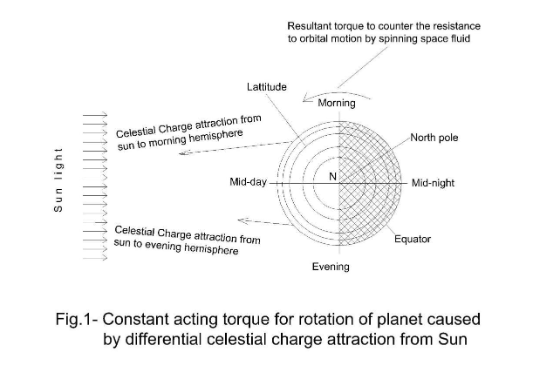
The circular orbit of a celestial body in the equatorial plane refers to the condition of metastable equilibrium under the action of gravity and centrifugal force. However, the orbital body is not free to move in the circular path. It moves in an elliptical path being guided by the charge shells of the extranuclear space structure of the central body.
Motive force for angular oscillation of axes of planets with respect to the sun
Planets experience gravity and centrifugal force and come to a floating state in the spinning space medium of the sun when the forces are equal and opposite. The planets orbit the sun being driven by the spinning extra nuclear space structure of the sun. Therefore, the expected orbital planes of planets are parallel to the equatorial plane of the sun. But Planets orbiting the sun in parallel planes are directed towards the equatorial plane of the sun by the resultant of gravity and centrifugal force (Fig.2a).
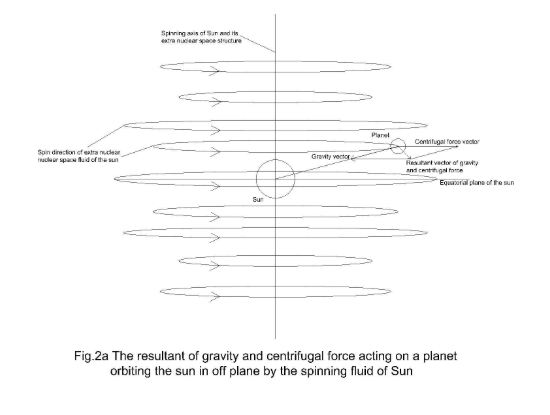
The resultant of gravity and centrifugal force can be resolved into two component forces 1) parallel to the equatorial plane and 2) perpendicular to equatorial plane (Fig.-2b). The force component 2 drives the orbital body towards the equatorial plane. The magnitude of force 2 gradually diminishes as the planet comes closer to the equatorial plane and vanishes totally on reaching the equatorial plane. But the planet continues its forward motion due to inertia. Force 2 reverses its direction after crossing the equatorial plane thereby opposes the inertial motion. The velocity slows down and becomes zero. Thereafter the planet reverses its motion and moves towards the equatorial plane. Thus, the planet makes a periodic oscillation in the direction perpendicular to its orbital plane. The magnitude fluctuation of force component 1 is also periodic and is in phase with the force component 2. The cause of elliptical orbit is discussed elsewhere [5]. The orbital motion of the planet is guided by the charge field structure (charge polarized shell features) in the extra nuclear space structure of the sun hence the planet makes radial oscillation in perpendicular to orbital motion. The force component 1 acts radially outward direction causing outward displacement within the orbit. The elliptical orbit aligns the direction of inclination of the orbital plane towards the major axis. The period of oscillation perpendicular to the equatorial plane matches with the period of revolution and this makes the inclination of the orbital plane. The periodic oscillation of the axis of the earth matching with the period of revolution of the earth makes the fixed inclination of the axis of the earth. The fixed inclination of the axes of all planets with reference to distant stars reveals oscillation of the axes of all planets relative to the axis of the sun. The oscillation of axes of planets, rotation of planets and the revolution of planets are primary motions. We have seen how the orbital motion and rotational motions have continuous driving force to make the motions perpetual. Now we shall discover the hidden motive torque that makes perpetual oscillation of the axes of planets.
While the axes of all planets oscillate with respect to the axis of the sun, the oscillation of the axis of the earth is considered as the case study. The celestial bodies carry celestial charge. The sun is positively charged and the earth is negatively charged [4] Hence there exists celestial charge attraction in addition to gravity. Thus, the centripetal attraction Cp is given by-
Cp = Gravity + celestial charge attraction
At present gravity is the only centripetal attraction because we are not aware of the celestial charge and its interaction. The negative celestial charge state of the surface of the earth reduces in day time by receiving positively charged solar radiation and increases at night by terrestrial radiation of positive charge photons. When the north pole is tilted towards the sun the northern hemisphere, on average, receives sunlight closer to normal compared to that of the southern hemisphere. Thus, the northern hemisphere remains less negatively charged compared to the southern hemisphere. For half the period of revolution the north-pole remains tilted towards the sun and in the next half period the south-pole remains tilted towards the sun. When the south-pole is tilted towards the sun, the negative celestial charge state in the southern hemisphere reduces compared to the northern hemisphere. In the new absolute charge concept, the charge attraction is a function of charge potential difference [6]. The phenomenon of oscillation of the axis of the earth is coupled with the periodic reversal of torque due to celestial charge attraction that helps to make the perpetual oscillation of earth’s axis with respect to sun by countering the resistance to motion offered by the spinning space fluid. The celestial charge interaction from sun to planet when the north pole of the planet is tilted towards the sun is shown in fig.2a. And when the South Pole is nearer to the sun the charge interaction forces are shown in fig.2b. The mass moment of inertia of the earth also plays a part in the dynamics of oscillation of the axis of the earth. The dynamics of oscillation of all planets is similar to that of earth. The dynamics of oscillation of the axis of satellites with respect to their planet is also similar to the sun-earth system.
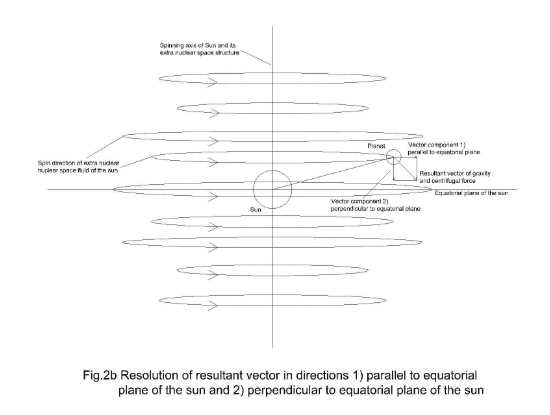
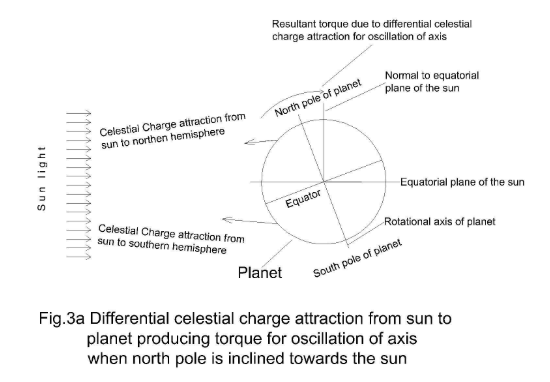
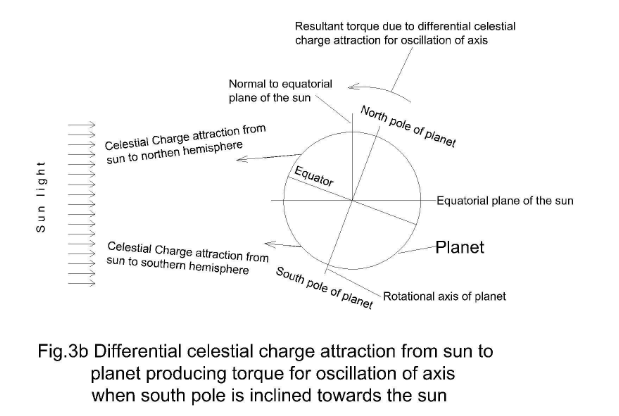
Conclusion
The new celestial charge interaction provides relevant torque for perpetual rotation and oscillation of axes of planets and satellites. These torques are absolutely necessary to maintain the speed of rotation and oscillation against the resistance offered by the spinning space fluid of the central body. The space is considered physical therefore the resistive forces for any motion are always present hence the assumption of uninterrupted free motion in empty space is not rational.
Reference
- https://philosophyofnature.org.in/basic-constituents-of-universe-and-their-interactions.
- https://philosophyofnature.org.in/mass-space-structure-of-centrally-organized-systems.
- https://philosophyofnature.org.in/direction-of-revolution-and-rotation-of-orbital-bodies.
- https://philosophyofnature.org.in/electric-and-non-electric-charges-and-their-inter-conversion.
- https://philosophyofnature.org.in/orbital-reality-of-planets-and-satellites-in-solar-system.
- https://philosophyofnature.org.in/new-concept-of-electric-charge-in-matter.
